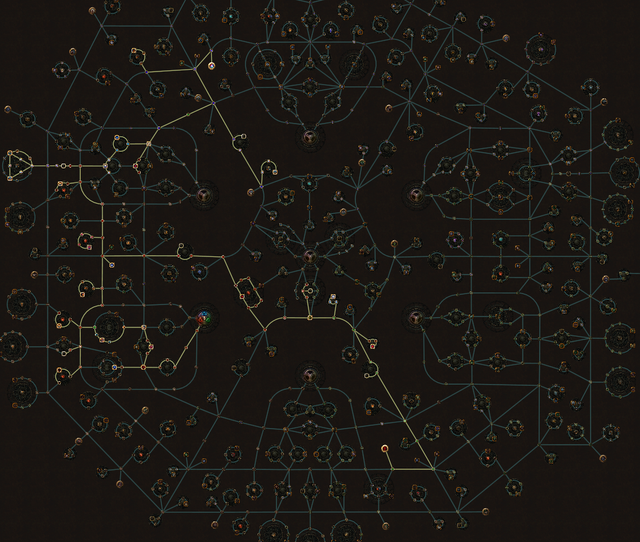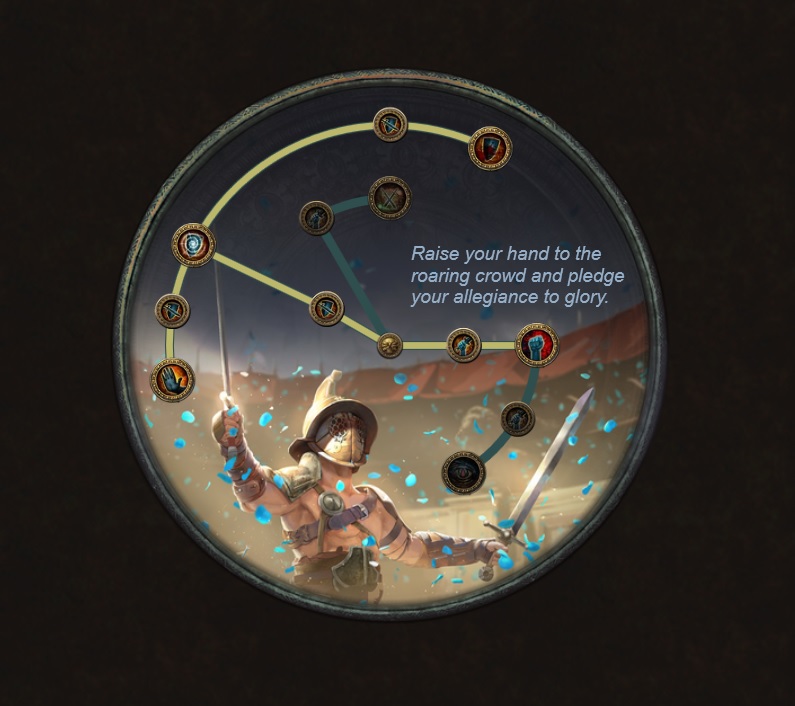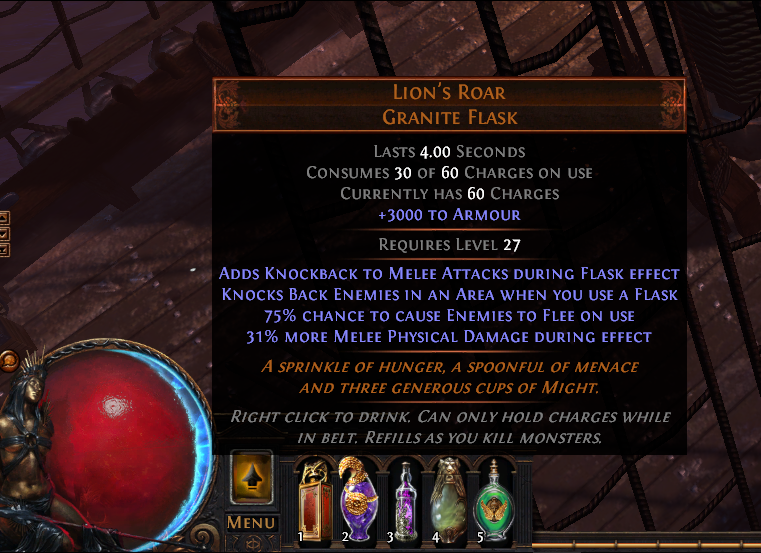Path of Exile - A whole new meaning within in depth game mechanics

You were left stranded in the land of Wraeclast, a dumping ground of sorts for criminals and other unsavory type. Forcing your way through countless of battles, against armies of the dead, unholy creatures and any living nightmare roaming the Wraeclast, as an exile, you have to make your way back to the land of Oriath. You armed yourself using numerous number of skill gems with countless combination of support skill gems. Vast amount of unique builds is at your disposal to make your way through Wraeclast.
From gem socketing mechanic to the way the game is played, Path of Exile is heavily influenced from Diablo series and Final Fantasy VII game. This free-to-play, ARPG game satifisfies your primal pleasure of carving your way through swarms of enemies, whether using melee weapon or magic wands. Path of Exile prefer balance in your build between your defense and offense. You might see your character became a glass cannon which do a lot of damage but dying pretty frequently if pumping the offensive part of your build is the only thing you do. Keep in mind every time you die you lost some of the experience points though.
The game has got many interesting mechanics ranging from the passive skill tree to items that have Unique rarity that can pretty much augment your whole build. However, the game’s mechanics is too complex for a new player to swallow down all the information in one seating. Heck, I have played this game for almost a year now and I still dont understand most of the game’s mechanics and they keep updating new items and skills every now and then.
Passive Skill Tree:
The first time I played it, I’ve got to be honest, I was intimidated by the passive skill tree. The developer Grinding Gear Games clearly cares little for streamlining comparing to other MMORPG games and that is what makes the passive skill tree a really unique one. The passive skill tree is so huge and it looks like a circuit board when zoomed out. Seven starter classes that you can choose in the character creation menu shares the same tree and they are nothing more than just a starting point on this passive skill tree. Given enough time and experience points, even a hulking Marauder could end up using bow and arrows like an agile Ranger at the end-game. Beat the campaign for the first time and you will also unlock the Scion, who can freely snake out from the center of the grid as she pleases.

If you look closely, you can see 7 starting point on center of the tree, which is for the 7 character in the game. This passive tree is used by Marauder which start at the Strength Status part of the tree.
Ascendancy:
Each of the seven characters can ascend to three classes of player’s choice with the exception of Scion, who can only ascend to Ascendant class. There are 19 total of ascendancy class available for you to choose, each with its own additional ascendancy skill tree to master. To ascend, players have to go through a series of trial to unlock the Lord’s Labyrinth, where then you can fight Izaro, the boss of the Labyrinth. Ascendancy is an important part of the game where you can really grow your character to fight most of the content of the end-game.

A passive skill tree of Gladiator ascendant, that started as a Duelist.
Skill Gem System:
The game’s main focus is around the skill gem system. Like a good Action Role Playing Game (ARPG), it has always been about two things: devastating skills and valuable items. Skills on Path of Exile are items which are called skill gems. These skill gems can be socketed on your equipment and grant you abilities. The skills can be further augmented using up to five support skill gems. For example, when Fireball skill is socketed with Multiple Projectile and Chain support skill gems, the Fireballs would split into three more projectiles and will chain to other mobs after the projectile hit an enemy.

Amount of skills you can play with is ridiculously huge, and this is not all of them. Image is taken from their website.
Item System and Leagues:
Path of Exile is also completely designed around items. The flasks are persistent items that can be mod to player’s need. You just have to kill monsters to refill your flasks. There are no gold or silver in this game as the currency to buy items in the game is used by orbs that can randomly reroll the properties of other items. GGG also keeps the game fresh by creating new leagues every three to four months that run frequently as separate game worlds with their own ladders and economies. In these leagues, players can take part in levelling race to show off their mastery of the game and compete to win valuable prizes. Each different league can substantially modify the game rules, such as new monsters and side quests that gets you items that has just been added to the game.

A unique flask that can boost your damage.
A brief lore of Path of Exile (minor spoiler):
Before the Beast, the common people could ascend, and reach immortality through adoration of their people. This has created many Gods that are powerful and ruthless in the world of Path of Exile. Among them are two brothers, Sin and Innocence. Soon after Sin became a God, he created the Beast to free humanity from the tyranny of the Gods.
The Beast was created and raised by Sin in order to surpress the divine power of the gods, preventing further strife between divine beings. The Beast possesses corrupting powers, but it itself has no will or ambition on its own. It devour the souls of his prey and mutating whoever comes in contact with it. Malachai, the Nightmare, initially wanted to destroy or tame the Beast and use its power to reshape the world. However, he failed and did not managed to control it. Instead, he entered the Beast’s Black core and became the Beast’s servant.
However, upon defeating Malachai throughout the gameplay, the Beast died with him, thus awaken all the surpressed gods, including Innocence and Kitava. Innocence, after being awoken, resides inside the High Templar Avarius, which gives Avarius divine power to took place into the Court of Divine Temperance in Oriath. This causes the Karui, a clan of warriors to rebel against the high Templar. During the rebel, the leader Utula manage to feed Kitava, the Karui God of Corruption, the souls of his people in order to increase its power. According to Karui tradition, Kitava is a cannibal deity with boundless hunger and has the power to consume and corrupt the souls of people. Now it is up to you to stop the gods from corrupting the world and put an end to the dystopia.
As you can see, the game have an overarching story line but unfortunately it is overshadowed by the combat system. Many people I know playing this game does not even know the story line because combat is rightly king here and the lore of the game can only be found by reading from NPCs and some historic stone you can found on your journey. If you are interested in playing this game, I would recommend you to read a build guide for your first character to pick up some knowledge of the game before making your own build. For me, the game is most satisfying when I work hard to theorycraft my build and grind for hours just to see my build working correctly at the end of the game. I enjoy playing this game and testing out most of the combination of items and gems to get the most easiest build to play, but still can survive and do a lot of damage (I’m still not there yet lol).
A gameplay of one of my builds! Enjoy!
With that being said, I really hope you enjoy this post, leave an upvote if you do and follow me for more content. I hope you have a nice day and I see you next time.